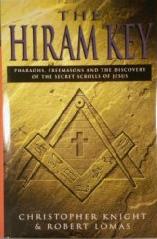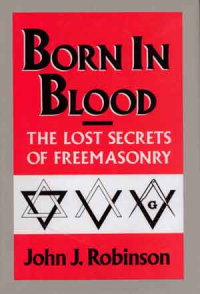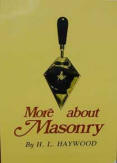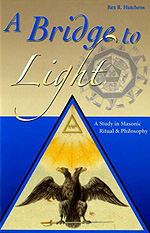|
The Hiram Key is one of those books that get a lot of commentary from the Masonic community either criticizing it for its aloof speculation or praising it for its imaginative nature and intriguing content.
The biggest problem with this book is that it is laced with speculation and spurious coincidences so much so that it allows itself to be taken as a work of fiction. Granted, there are many stretches of fact in this book to accommodate a lack of written history. From their opinions on the relative nature of Freemasonry and Jesus’ life to their suspected evidence of finding the “Third Baseman”, Knight and Lomas paint a picture that can hardly be regarded as fact or truth. Their investigative methods are lacking in many ways and they seem to go from point A to D without accounting for B or C. However, I thoroughly enjoyed this book. The reason I was able to enjoy it was that I was cognizant of the fact that Knight and Lomas have an uncanny ability to tell a fantastic Masonic story as seen in their other writings. The emphasized word here is STORY. If you approach this book as a form of entertainment and take its content light heartedly you will have an interesting read. If you expect to get cold hard facts about the history of Freemasonry from this book they you might as well move on to another title. The Hiram Key has been called The DaVinci Code for Freemasons, and in a way that analogy is correct. Just as Dan Brown has fused historical fact with an imaginative history and applied it to a storyline, Knight and Lomas have done a similar thing. They have taken the few facts we have on Freemasonry, did a bit of research and investigating and applied them to a storyline. Lomas even says in one of his interviews “There are no hard facts regarding these gaps in history, but it makes for a great story.” With that in mind, take this book and read it for entertainment because it is entertaining. Not at all times factual, even sometimes ire inducing to some Freemasons, but never the less fun discussion material. Review by John A. Nichols
5 Comments
Born in Blood is another one of those books that are very enjoyable for its entertainment value. In this book John J. Robinson attempts to link the origins of Freemasonry back to the Knights Templar who make their re-appearance in history during the English Civil War. Similar to The Hiram Key in that it uses the little known facts on the origins of Freemasonry, fuses them with the historical facts of the era and produces a linear account relating the two. However, Robinson’s historical accuracy may be a bit more verifiable considering the availability of medieval history compared to biblical history in that he was originally a medieval historian. Incidentally, whenever someone attempts to write a history of Freemasonry, the further back in history you go the more speculation you will receive.
The problem with this book, like The Hiram Key and a few others is its speculative nature. Sometimes these books get too speculative as to lose credibility. But the counter to the argument against the Templar Myth is that it cannot be disproved. The same goes with the other ideas on exactly when, where and how the fraternity of Freemasons originated. This book does give the reader an interesting history on what may have been or might have happened. Robinson’s writing and investigative findings are a bit cleaner than Knight and Lomas’, so it reads more like an historical account. Even though Robinson wasn’t a Freemason until the last days of his life, he was still a fervent supporter of the fraternity. This lack of Masonic credentials has come into play when critiquing his book as it should, but if you approach this book as strictly a speculative view of Masonic history then you will find enjoyment in this interesting account of the Freemasons before modern history. Review by John A. Nichols H.L Haywood is one of the fraternity’s most prolific writers of the 20th century. His several works have provided Freemasons with better knowledge of the fraternity, its history, philosophy and aims.
You won’t find this book on the shelves of Borders or Barnes and Noble because unlike Knight, Lomas, Robinson and others, Haywood sticks to the facts and the majority of books on Freemasonry at walk-in retail stores are coincidental history at best. In this book there is no fluff, no spectacular historical fantasies about knights, Egyptians or a long lost secret knowledge. Haywood addresses the many facets of the fraternity that go unchecked a lot of the time. From officer duties, politics, revenue/resources, structure, jurisdiction, jurisprudence and a slew of other topics essential to a Freemasons repertoire of knowledge, Haywood gives the reader a factual account of how the fraternity works, what its purpose is and the documented history of the fraternity we have today. The one downside to this book is that it can be long winded at times in Haywood’s explanations and analogies. Also, for the Mason looking for a fast paced thrill ride of Masonic history, he will probably be put to sleep in the first few chapters. This book simply does not have any of that. However, for the reader looking for cold hard facts, verifiable, documented, traceable and relevant, this book is a gem. The chapters are but a few pages long and he addresses each issue separately, thoroughly and intelligently. There is no question that Haywood was not only a great writer, but also a lover of Masonic knowledge. This book is perfect for those who wish to come back to Earth and learn what Freemasonry is without all of the unnecessary theories of peripheral, unsubstantiated tales of speculation and a must have in any Freemasons library. Review by John A. Nichols For many Freemasons, especially Scottish Rite Freemasons of the Southern Jurisdiction, the former book issued to Scottish Rite Masons,Morals and Dogma by Albert Pike seems outdated, cumbersome and difficult to read. Pike’s Victorian style of writing, language and copious use of references to the cultures and religions of ancient societies may make his book seem (to some readers) like intellectual overkill.
Today every Scottish Rite Mason of the Southern Jurisdiction receives A Bridge to Light by Dr. Rex R. Hutchens 33° GC. This excellent piece of work is more of an abridged version of Pike’s Morals and Dogma and a must read for every Scottish Rite Mason. In this book Hutchens breaks down each of the Scottish Rite degrees and in a simple and readable fashion communicates the tenets, symbolism, philosophy, duties and questions for reflection of each of the degrees. Hutchens’ explanation of Scottish Rite philosophy is more concise than Pike and more comprehendible to much of the readers of today. Complete with regalia illustrations and relative imagery, Hutchens has taken the vast amount of Scottish Rite philosophy as communicated in the degrees and has produced a valuable piece of work without which the elements of Scottish Rite philosophy might have been subject to not only years of misinterpretation, but possibly complete neglect. However, if you wish to jump in with both feet and endeavor to readMorals and Dogma, then I suggest you have by your side A Glossary of Morals and Dogma also by Hutchens and The Bible in Morals and Dogmaby Hutchens and Donald Monson 33°. Review by John A. Nichols |
BOOK REVIEWSA general blog for any Acacia member to review books they have read. Categories |




 RSS Feed
RSS Feed